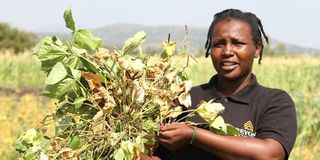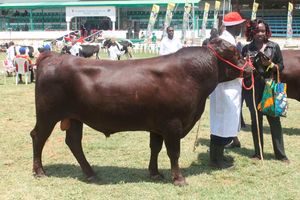
Miriam Kitunge harvests black gram in Kavuthu village, Makueni County, on January 23, 2025. The lentil is resistant to drought and pests.
Anxiety gripped Kitui, Machakos and Makueni counties when the October-December rains failed.
In Kavuthu village of Makueni County, however, Miriam Kitunge did not seem worried.
The 25-year-old expected a bumper harvest. She is among the few farmers in the region who grow black gram, a lentil that is resistant to drought.
“When everyone else was flocking to the green gram value chain, we chose another route. We have not given it a specific name but just call it ndengu like the ordinary green gram,” Kitunge tells the Seeds of Gold team at a plot teeming with the crop.
Known scientifically as Vigna mungo, black gram traces its roots to India where it is used as animal and human food.
Black gram thrives in the same agronomic environment as the green gram or mung bean. Telling them apart is difficult, especially from a distance. A tour of one of Kitunge’s black gram plot is edifying.
“Black gram pods are black and hairy compared to those of green gram which are brown and smooth. Black gram pods are relatively shorter. We have established that a black gram plant produces more pods than green gram,” she says.
From her confidence, it is difficult to tell that Kitunge is barely two years old in the agribusiness venture.
Though she grew up running errands for her parents as they farmed beans and sorghum in Kajiado and Makueni Counties, the Pwani University Survey graduate took long to develop an interest in farming.
She says scales fell from her eyes after a short course on agronomy in 2023.
The three-month programme was sponsored by the NGO Cabi and the Makueni devolved government. It was meant to churn out extension officers who would support farmers at a fee.
After the course, Kitunge made the decision to try a hand in agribusiness. Around that time, Spice World Ltd, a local firm that processes and markets grains and pulses, contracted farmers in the area to grow black grams.
As many of her neighbours assumed the wait-and-see approach, Kitunge and Francis Musyoki – a local politician – joined a handful of farmers who tried the crop.
Kitunge harvested 70 bags of black grams from a 10-acre piece, every bag weighing 100 kilogrammes.
Apart from growing the crop on leased plots, Kitunge is into black gram aggregation.
“Two months after the extension course, we aggregated black gram valued at Sh960,000. A kilo fetched Sh120 as green gram sold for Sh50,” she says.
The following planting season saw an increase in black gram interest.
“We produced 18 tonnes of black gram before the yield increased to 30 tonnes the following planting season. This earned the small black gram community in Kavuthu Sh3.6 million,” Kitunge says.
According to the Kenya Agricultural and Livestock Research Organisation (Kalro), black gram is among the four varieties of mung beans in the market.
“There are brown and yellow ndengu varieties but these have not found favour with farmers and the community,” says Nixon Mutinda, a Kalro mung bean researcher in Katumani, Machakos County.
“When we are rolling out new crop varieties, we involve farmers as they are the end users. In vain have we attempted to promote the black, brown and yellow mung bean. Farmers prefer the green gram. Colour is an important dimension.”
Yet, according to Daniel Munene – a procurement manager at Spice World – black gram is hot cake at high-end markets where it is seen as a good source of protein.
“The black gram venture is highly profitable. The crop is rarely attacked by pests, reducing the cost of production,” Musyoki says.
“Unlike green grams, the black gram ends up in the market since we do not see it as food. Not many people know how to prepare it. This translates to increased earnings to farmers.”
He is the face of a handful of smallholder farmers who grow black gram in Makindu where the sun burns fiercely.
The first step when growing black grams is tilling the land properly.
This is followed by making furrows that are three to five centimetres deep and then burying the seeds.
Agronomists say six kilogrammes are needed for an acre.
“Like green grams, black grams yield optimally in regions that receive 350 to 600mm of rainfall a year. This makes it a suitable crop in dry and semi-arid regions,” Musyoki says.
Weeding is an apt management practice since black gram is not attacked by pests.
“The crop takes around 70 days to mature. An acre produces six to eight 100kg bags, depending on how one manages the crop,” Kitunge says.
The World Food Programme and Makueni County government have placed Kitunge and a handful of young farmers at the centre of a programme to spur agribusiness and promote climate-smart agriculture.
According to George Kamami, the coordinator of the young model farmers programme, the farmers are tasked with inspiring a new generation of Kenyans by promoting the uptake of drought resistant crops.











